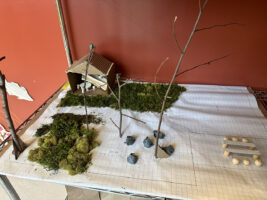Each year, the 5th Graders at Fieldston Lower undertake an ambitious and multifaceted Shark Tank Project — combining elements of math, science, research, design, writing, technology, and more. This project not only challenges their intellectual abilities but also tests their collaborative skills and aptitude for manage complex, real-world problems.
Inspired by the entrepreneurial TV show, the project asks students to conceptualize and design an outdoor classroom in the Fieldston Lower Garden that is both sustainable and accessible and pitch their ideas to a panel of “sharks.” The journey begins with a central question: “What strategies do people use to create change?” This question sets the stage for students to develop business models for products aimed at addressing climate change.
In addition to the many academic skills needed to complete this project — from area and perimeter measurements to research, persuasive writing, and computer design — the project also requires effective cooperation among students. “One of the most challenging aspects of the project is the demand for collaboration over its duration,” explains 5th Grade Head Teacher Dani Cardia. “Together, our students must thoughtfully consider the existing environment while developing plans, incorporating current garden elements, and selecting native plants that will thrive.”
Given the assignment’s extensive scope and duration, students must work closely in groups of three or four, coordinating their efforts and ideas. This involves constant communication, negotiation, and compromise, pushing students to develop and hone their interpersonal skills. For many 5th Graders, this level of teamwork and collaboration is a new and challenging experience, requiring patience, resilience, and adaptability.
The 5th Grade teachers encouraged students to assign tasks independently, ensuring that each member of the group had an equal opportunity to contribute ideas and take ownership of the final design.
For example, one group member may understand the ecological balance of the garden and another may be charged with ensuring the group’s design prioritizes sustainability. They do extensive research to make informed decisions about which plants to cultivate, considering factors such as soil compatibility, water requirements, and local wildlife support. Based on their research focus, each student must become an “expert” in one area and share what they learn with their other group members.
Adding to the challenge, each group is tasked with designing a lesson plan to teach younger students about the garden. This requires the 5th Graders to think creatively about how to engage and educate their peers meaningfully. Crafting these lesson plans pushes them to think from the perspective of both a teacher and a learner, ensuring that the content is accessible and engaging for younger students.
“The toughest part has definitely been working together and communicating with each other,” explains 5th Grade student Adaeze O. ’31.
“But I also think that when we are talking things through, we come up with the best possible ideas,” adds Aashna M. ’31.
Other research elements include developing knowledge of various plant species to determine the best use for the garden plantings, exploring options like growing food, cultivating plants for natural dyes, supporting pollinators, or creating a sensory garden. Students considered gray water usage, rain catchment systems, and renewable energy sources to minimize environmental impact.
Before developing their final garden designs, students also work together to write persuasive essays on their chosen topics. “During this time, students identify the issues and stories that feel most relevant and powerful to them,” says 5th Grade Teacher Rebecca Butler. “We encourage them to dream big, fact-check, and use statistics as part of their arguments to influence others to join their concerns.”
“The project’s cumulative nature helps students grasp the interconnectedness of the world and the value of collaboration. Students who focus on plastic waste learn that it harms not only humans but also sea life and that it disrupts the food chain. They also begin to link their research and collaborate with groups focused on renewable energy,” explains Cardia.
In June, the project culminates with students presenting their ideas to the panel of “sharks.” To prepare, they work together to write a script and assign roles to each team member for the presentation. “We each have different things to highlight to convince the Sharks to invest in our design. After working together for weeks, we know each other’s strengths well. This will make our presentation strong,” says Adaeze.
This project not only challenges 5th Graders to think critically and creatively but also instills in them a sense of responsibility to each other and to the greater world. By integrating many skills, they are developing a framework that will serve them well when looking for solutions to complex problems in the future.














